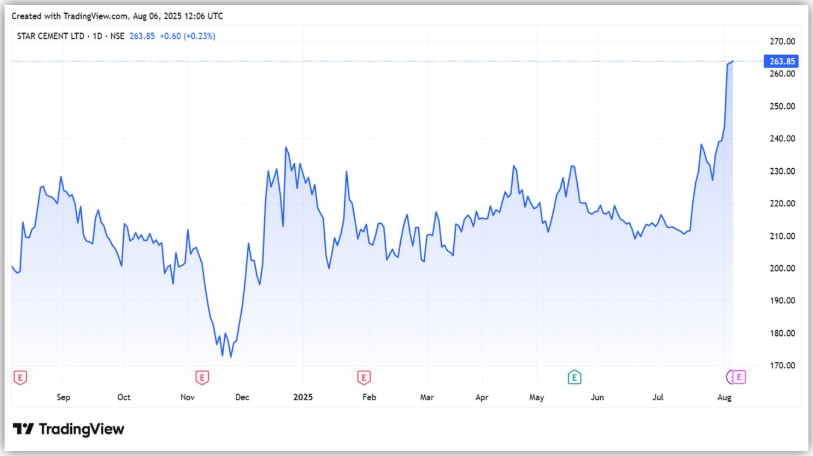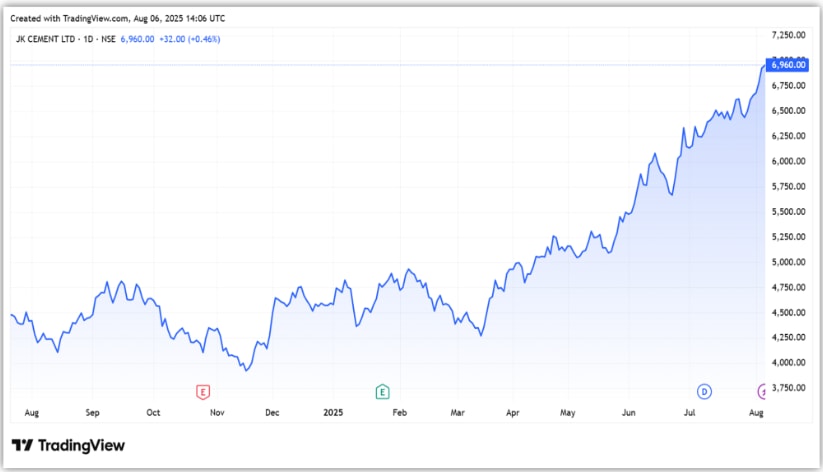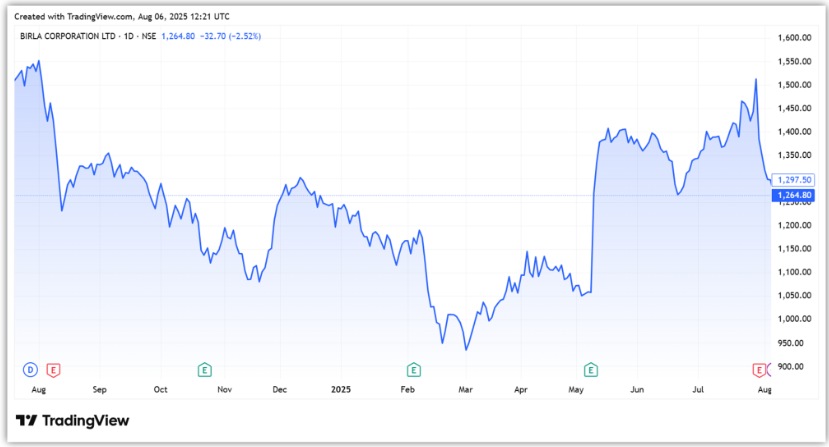Cement stocks have been outperforming the broader market after muted growth in the last few years. It’s because of strong profit growth, demand momentum, and price hikes. Crisil expects demand growth to move up to 6.5%–7.5% in FY26 from 4.5%–5.5% last year. Price increases, which began in December 2024, have held firm. So far, rates have increased by over 3%, and an additional 2%–4% may be added this year.
Both volumes and pricing are improving. That usually reflects in better revenue and steady margins. As a result, cement companies have also reported strong profitability in Q1FY26. In addition, the pickup in construction, which was subdued last year, is also expected to keep the demand strong.
The market is beginning to reprice growth. We’ve selected three stocks with solid results in Q1FY26. Also, their stocks are outperforming the broader market. Let’s take a look.
#1 Star Cement
Star Cement is a leading cement company in North-East India, with a 27% market share in the region. It also has a presence in eastern India, mainly in West Bengal and Bihar. To diversify its presence, it plans to set up a plant in Rajasthan in 3-4 years.
The company holds a cement manufacturing capacity of 7.7 metric tonnes per annum (MTPA) and clinker manufacturing capacity of 6.1 MTPA. Due to the limited presence of pan-India players in the region, Star commands higher pricing than its peers.
Strong Q4 Performance Boosts Investor Confidence
Its performance has been relatively strong in the last quarter. In Q4FY25, the company’s cement and clinker sales grew 10% YoY to 1.53 MT. As a result, revenue rose 15% to ₹10.5 billion. With improved operational efficiency, EBITDA grew 43%, improving margins by 500 basis points (bps) to 25.5%.
EBITDA stands for earnings before interest, tax, depreciation, and amortisation. As a result, profit after tax (PAT) grew 41% to ₹1.2 billion. It recorded its highest ever revenue, EBITDA, and PAT. EBITDA/tonne, a key measure of profitability, also grew 34% to ₹1,815.
The company has yet to declare results for 1QFY26.
Backed by strong results, Star’s share has outperformed the market with a return of 22% in the last 6 months. In the same period, the NSE Nifty 50 is up 4.1%. It is trading at an all-time high of ₹261.

Capacity Expansion and Premiumisation Strategy in Focus
Looking ahead, it has set a target of 5.5 MT of cement volume in FY26. The company said that in Q1FY26, prices in the Northeast and outside this region have increased by an average of ₹5-7 per bag. The company aims to maintain these prices, and though some reduction is possible in the off-season.
Notably, Star Premium Cement sales are growing rapidly, accounting for 12% of total sales in Q4FY25, up from 5-6% last year. The company expects this to reach around 20% in the coming year.
Like its peers, Star also plans to expand its cement capacity to 9.67 MTPA and 12 MTPA by FY27. For this purpose, the company plans to invest ₹8.2 billion in FY26 and ₹6 billion in FY27. One grinding unit is expected to be commissioned in FY26 and the other by the fourth quarter of FY27.
Rajasthan Foray Could Mark a Turning Point
Besides, it has also acquired mines at Nimbol in Rajasthan and is currently evaluating them. If they move ahead, the facility will have a grinding capacity of 4.45 MT and a clinker production capacity of 3 MT, taking the total production capacity to 16-17 MTPA.
From a valuation perspective, it is trading at an EV/EBITDA multiple of 19x, which is higher than the 10-year median of around 10x.
#2 JK Cement
JK Cement is among the largest manufacturers of white cement (including wall putty) in India and globally. It has a total white cement and wall putty capacity of 3.05 MTPA. The Indian white cement market has high entry barriers and limited competition, making it a two-player space.
On the grey cement side, JK Cement has a capacity of 25.3 MTPA, ranking it sixth in the country. Its operations are spread across Central, Southern, and Western India, supporting geographical diversification.
Strong Operating Leverage Drives Q1 Performance
In Q1FY26, JK Cement’s net sales grew only 19% YoY to ₹32 billion, driven by strong volume growth. Grey cement revenue rose 23% to ₹25 billion, accounting for 78% of total revenue. The remaining revenue came from white cement sales, whose revenue grew 9% to ₹7.4 billion.
Consolidated EBITDA grew 41% to ₹6.9 billion, while margins expanded by 330 bps to 21.2%. With operating leverage, net profit rose a massive 75% to ₹3.4 billion. JK Cement’s standalone business EBITDA/per tonne also rose 23% to ₹1,247.
Capacity expansion on track
Looking ahead, a 6 MT greenfield and brownfield expansion project is on track. The project is expected to be completed by the end of this year. Once commissioned, its total grinding capacity will increase from the current 25.3 MT to 31.3 MT.
The company also expects to invest ₹26 billion for expansion by FY27. The company is targeting sales of ₹20 MT in FY26, despite the weak monsoon. It has also entered Bihar and expects to sell 1 MT in that market. In terms of pricing, its realisation is higher in the south, while North and central regions are witnessing marginal pressure.
Valuations above the long-term average
JK Cement’s share price has gained 42% in the last 6 months. In the same period, the NSE Nifty 50 has gained 4.1%. The company’s stock is trading at an all-time high of ₹6,957.5.
As a result of this sharp rally, the company’s valuation is now significantly higher than its long-term median valuation. JK Cement now trades at an EV/EBITDA of 24x, a premium to the 10-year median of 17x.

#3 Birla Corporation
Birla Corporation, part of the MP Birla Group, manufactures cement and jute goods. The company holds a strong position in the central region, with a market share of 11%. Its current capacity stands at 20 MTPA, with operations spread across Western, Central, Northern, and Eastern regions.
Strong Q1FY26 Performance
In Q1FY26, Birla Corporation’s revenue rose 12% YoY to ₹24.5 billion, driven by a 9% increase in sales volume. The company witnesses strong demand and pricing in the Western and Eastern markets, where it recorded 15-18% volume growth.
As a result, EBITDA margin expanded by 230 bps to 14%. Key profitability metrics, EBITDA/tonne rose 23% to ₹725, due to higher realisations, operating leverage, and cost efficiency. Net profit grew by 3.3 times to ₹1.2 billion, from a lower base.
Growth Momentum Expected to Strengthen in FY26
While near-term visibility remains stable, full momentum is expected in FY26, and sales are expected to grow by 6-7%. The company’s capacity utilisation improved to 96% in Q1FY26 (from 88% in Q1FY25), reflecting strong demand.
In price trends, the central region remained relatively stable, while the eastern region benefited from price increases. But the contribution to Birla’s sales mix remained marginal. It is also benefiting from the premium segment.
The premium share in the Mukutban region grew to 50% from 40% in Q1 FY26. Premium brands like Perfect Plus and Samrat Advanced are strong in Uttar Pradesh and Madhya Pradesh.
The company plans to focus on value share over volume share due to the current limitations of its clinker capacity. Clinker capacity is expected to increase from 13 MTPA to 16.7 MTPA, and grinding capacity from 20 MTPA to 27.6 MTPA.
Valuations Appear Reasonable
From a valuation perspective, Birla Corporation trades at an EV/EBITDA multiple of 9x, in line with the 10-year median of 10x. From February 6 to July 29, Birla Corporation shares rose 30% to ₹1,535. However, since then, it has fallen 18% to ₹1,262 due to profit booking. But, it is still up 6% in the last 6 months, outperforming the NSE Nifty 50’s gain of 4.1%.

Conclusion
The Indian cement industry could be heading into a better phase in FY26, supported by infrastructure projects and steady housing demand. Management commentary also reflected optimism on volume growth. Star Cement, JK Cement, and Birla Corporation have already posted strong numbers in Q1FY26, backed by favourable demand.
Disclaimer
Note: Throughout this article, we have relied on data from http://www.Screener.in and the company’s investor presentation. Only in cases where the data was not available have we used an alternate but widely used and accepted source of information.
The purpose of this article is only to share interesting charts, data points, and thought-provoking opinions. It is NOT a recommendation. If you wish to consider an investment, you are strongly advised to consult your advisor. This article is strictly for educational purposes only.
About the Author: Madhvendra has been deeply immersed in the equity markets for over seven years, combining his passion for investing with his expertise in financial writing. With a knack for simplifying complex concepts, he enjoys sharing his honest perspectives on startups, listed Indian companies, and macroeconomic trends.
A dedicated reader and storyteller, Madhvendra thrives on uncovering insights that inspire his audience to deepen their understanding of the financial world.
Disclosure: The writer and his dependents do not hold the stocks discussed in this article.
The website managers, its employee(s), and contributors/writers/authors of articles have or may have an outstanding buy or sell position or holding in the securities, options on securities or other related investments of issuers and/or companies discussed therein. The articles’ content and data interpretation are solely the personal views of the contributors/ writers/authors. Investors must make their own investment decisions based on their specific objectives, resources, and only after consulting such independent advisors as may be necessary.

